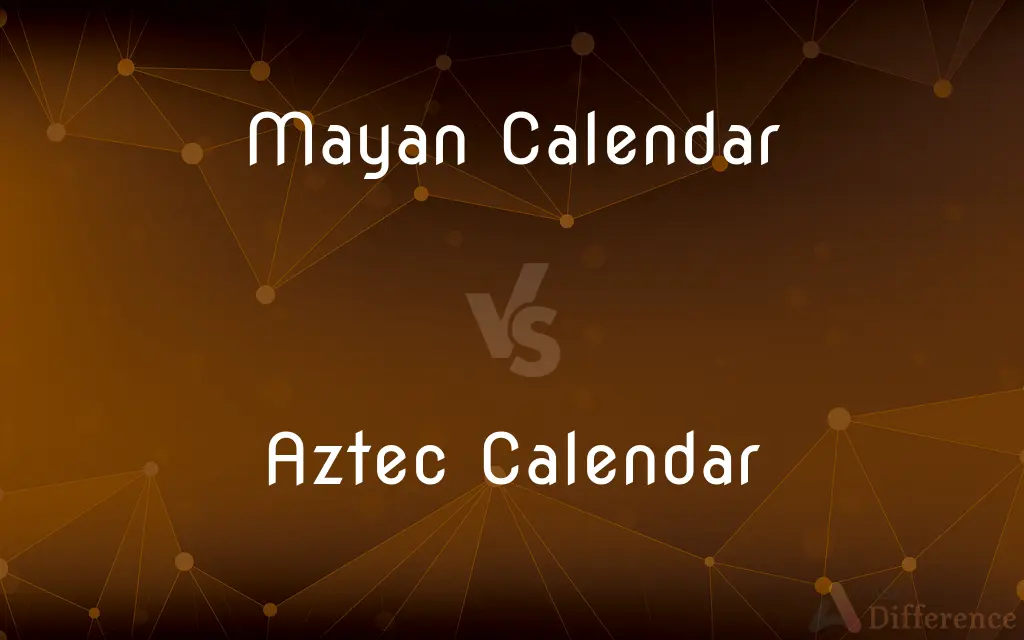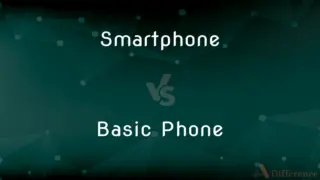Mayan Calendar vs. Aztec Calendar — What's the Difference?
By Tayyaba Rehman — Published on November 18, 2023
Mayan Calendar uses a cyclical system featuring several cycles, while the Aztec Calendar encompasses two separate calendar systems.

Difference Between Mayan Calendar and Aztec Calendar
Table of Contents
ADVERTISEMENT
Key Differences
The Mayan Calendar, developed by the ancient Mayan civilization, is renowned for its intricate cyclical system, entailing multiple cycles that interact and coincide with one another. The calendar is renowned for its Long Count, Tzolk’in (a 260-day ceremonial calendar), and Haab' (a 365-day solar calendar). These three cycles work concurrently, with the Tzolk’in and Haab' cycles creating a larger 52-year cycle. The Mayan Calendar is often commended for its astronomical precision and the complex interlocking of its various cycles.
In contrast, the Aztec Calendar from the Aztec civilization, while sharing some similarities with the Mayan system due to cultural exchange, possesses its unique attributes. The Aztec Calendar is predominantly characterized by two main calendar systems: the Tonalpohualli, a 260-day sacred calendar, and the Xiuhpohualli, a 365-day agricultural calendar. These two cycles run in parallel and align every 52 years, which is deemed a century in the Aztec system. The Aztec Calendar integrates both the spiritual and practical aspects, considering the celestial and the agricultural.
Exploring the Mayan Calendar further, it is pivotal to recognize that it reflects the Mayans' advanced astronomical and mathematical understanding. This calendar accurately pinpoints celestial events and is configured to chronicle a linear history, serving both practical and ceremonial purposes. The Long Count specifically allows the tracking of extended chronological periods, enabling the Mayans to specify dates with a considerable historical depth.
Shifting focus to the Aztec Calendar, this system also intricately integrates the civilization’s spiritual and daily life, yet with a different structural approach. The Aztec Calendar, particularly through the Tonalpohualli, divides the 260-day cycle into 20 periods of 13 days, associating each day with a god and thus infusing daily life with spiritual significance. Moreover, the 365-day Xiuhpohualli, intertwined with agricultural routines, further connects the earthly and divine by organizing the agricultural year and ceremonial events.
It is essential to highlight that both the Mayan Calendar and Aztec Calendar have garnered significant attention due to their historical, astronomical, and prophetic interpretations. While the Mayan Calendar is often (erroneously) linked to various end-of-the-world prophecies, the Aztec Calendar is deeply embedded in the civilization's mythology and spiritual practices, such as the legend related to the Five Suns, representing different epochs of existence.
ADVERTISEMENT
Comparison Chart
Primary Cycles
Tzolk’in, Haab', Long Count
Tonalpohualli, Xiuhpohualli
Cultural Focus
Astronomical, historical
Spiritual, agricultural
Historical Misconceptions
Associated with apocalyptic prophecies
Less focused on long-term prediction
Configuration
Multiple interacting cycles
Two parallel and coinciding cycles
Societal Integration
Broadly used in various cities
Centralized in the Aztec empire
Compare with Definitions
Mayan Calendar
Features the Tzolk’in and Haab' cycles.
The Mayan Calendar utilizes the Tzolk’in cycle for ceremonial purposes.
Aztec Calendar
Infuses daily life with spiritual connotations.
Every day in the Aztec Calendar carries a divine association.
Mayan Calendar
Intertwines astronomical and ceremonial elements.
The Mayan Calendar precisely predicts celestial phenomena.
Aztec Calendar
Binds spiritual and earthly aspects.
The Aztec Calendar uniquely combines celestial and practical elements.
Mayan Calendar
Allows tracking extensive chronological periods.
Historical events are logged in detail in the Mayan Calendar.
Aztec Calendar
Synchronizes agricultural and ceremonial timelines.
The Xiuhpohualli in the Aztec Calendar is vital for agricultural planning.
Mayan Calendar
Incorporates a complex cyclical system.
The Mayan Calendar effectively intertwines several cyclical systems.
Aztec Calendar
Consists of Tonalpohualli and Xiuhpohualli.
The Aztec Calendar integrates spirituality with the Tonalpohualli cycle.
Mayan Calendar
Engaged in various end-time prophecies.
The Mayan Calendar was inaccurately tied to 2012 apocalypse theories.
Aztec Calendar
Aligns two primary cycles every 52 years.
A century in the Aztec Calendar is marked by the convergence of its two cycles.
Common Curiosities
Are the Mayan Calendar and Aztec Calendar completely distinct?
No, they share some similarities due to cultural exchanges.
What are the main cycles of the Mayan Calendar?
The Tzolk’in, Haab', and Long Count.
How does the Aztec Calendar incorporate spirituality?
Through attributing gods to days and cycles.
Which civilizations created the Aztec Calendar and Mayan Calendar?
The Aztec and Mayan civilizations, respectively.
What are the core components of the Aztec Calendar?
The Tonalpohualli and Xiuhpohualli.
Is the Mayan Calendar still in use today?
Some modern Mayan communities still observe it.
What is the Mayan Calendar best known for?
Its precise astronomical calculations and cyclical systems.
Are the cycles in the Mayan Calendar interconnected?
Yes, they function in a synchronized manner.
Do the Mayan and Aztec calendars have a linear concept of time?
Both perceive time cyclically, albeit expressed differently.
How are the Mayan and Aztec calendars studied today?
Through archaeological findings and historical texts.
Does the Mayan Calendar predict the end of the world?
No, that’s a common misconception.
What is the significance of the 52-year cycle in the Aztec Calendar?
It marks a century and a significant rebirth in Aztec beliefs.
How does the Aztec Calendar intertwine with agricultural practices?
Through the Xiuhpohualli, which organizes the agricultural year.
Is the Long Count unique to the Mayan Calendar?
Yes, it specifically allows tracking of extensive periods.
What is a "century" in the Aztec Calendar?
It is a 52-year period when two cycles align.
Share Your Discovery

Previous Comparison
High Culture vs. Popular Culture
Next Comparison
Smartphone vs. Basic PhoneAuthor Spotlight
Written by
Tayyaba RehmanTayyaba Rehman is a distinguished writer, currently serving as a primary contributor to askdifference.com. As a researcher in semantics and etymology, Tayyaba's passion for the complexity of languages and their distinctions has found a perfect home on the platform. Tayyaba delves into the intricacies of language, distinguishing between commonly confused words and phrases, thereby providing clarity for readers worldwide.
















































